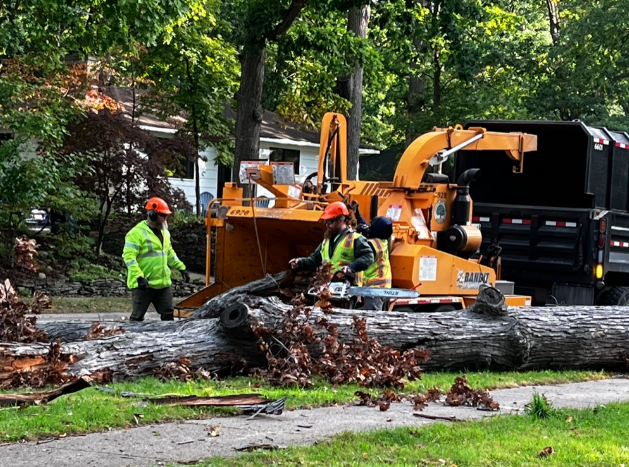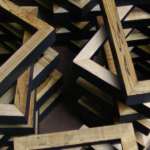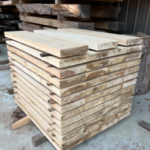
- Kim Kisner
- Business
- 07/11/2023
The City of Ann Arbor is Changing the Way it Processes Urban Wood with the Help of Urban Ashes

According to Tiffany Giacobazzi, Ann Arbor urban forestry & natural resources planning coordinator the Ann Arbor Forestry Department, the city of Ann Arbor loses about 600 trees per year. This reduces its carbon storage capacity dramatically.
Much of the loss sits within furniture-grade urban lumber, meaning the trees can be repurposed for furniture or other long-lived urban wood goods that aid in sequestering carbon, versus being used for mulch or firewood or being diverted to landfills.
Ann Arbor has partnered with Urban Ashes to implement its Circular UrbanWood Triconomy™ (CUT Model™). This model is meant to ensure that logs are put to their highest and best use to sequester as much carbon as possible.
SBN Detroit spoke with Paul Hickman, Urban Ashes founder, CEO, and principal designer, and Tiffany Giacobazzi, Ann Arbor urban forestry & natural resources planning coordinator, to find out more.
Q: What is Urban Ashes, and how did this program with Ann Arbor come to be?
Hickman: I will provide a little background here for context because Urban Ashes has gone through a bit of an evolution.

Initially, it started with a major career change for me by taking a job in California with one of the first sustainable lumber companies in the world. I eventually moved back to Michigan and started the original Urban Wood Project with three others in the early 2000s in response to the infestation of the emerald ash borer to help utilize trees beyond mulch, which was the most common response for the disposal of ash trees then and now. That was the impetus, but it immediately expanded to include all fallen urban trees and into Urban Ashes.
Urban Ashes grew to sell to over 250 retail partners across 43 states over ten years, repurposing hundreds of tons of lumber into picture frames, furniture, and other items.
From the beginning, our focus was also to work with formerly incarcerated individuals as a labor force, and that remains a strong component of the Urban Ashes business model today.

Over time, the lack of wraparound (support) services (for workers) took a heavy toll, and eventually, we shifted entirely, shut down our manufacturing, and decided we needed to focus on building the infrastructure to develop the supply chain more thoroughly and consistently and grow the markets for utilization as well as develop the critically needed wraparound services needed for our target labor pool.
So, we partnered with NextCycle Michigan and went through their FLOWS track which led to an EGLE grant. Then came the vision for the Circular UrbanWood Triconomy™. We were fortunate enough to work with the University of Michigan graduate students for 18 months to validate the viability of the model, and beginning in 2021, we have piloted it with the city of Ann Arbor.
Q: How and why did the city of Ann Arbor come to change the way it processes trees and work with Urban Ashes?
Giacobazzi: As the city has shifted with its sustainability goals and A2Zero plan, we started to look at how we could divert more out of the waste stream. We wanted to achieve the highest best use for materials that come out of the urban forest.
So, we connected with Urban Ashes and partnered on this project. I have support all up and down the line from city administration which is really important. We are fundamentally changing the way we are dealing with urban wood and our urban forest so we must all be in support of this new process.
Q: What does this program involve?
Hickman: For years, all fallen urban trees in Ann Arbor (as is the case with most cities) were used for mulch or firewood. Accordingly, Ann Arbor loses approximately 1,111 metric tons of carbon every year and we were able to show them that by implementing the CUT Model™, we can capture upwards of 700 metric tons of that 1,111 and keep it in use and sequestered.
The process involves cutting the trees down in a way that holds the most carbon and is best suited for the mills. The process also involves setting up the mills, facilities, contracts, and tracking methods, and then implementing everything. So, that is the work that Urban Ashes has been doing.

Q: What do you, as the Urban Forestry and Natural Resources Planner, hope to achieve through Circular UrbanWood Triconomy™?
Giacobazzi: I want to make sure the trees and lumber that have to come out in Ann Arbor go to the best use possible. I want it diverted from the waste stream and we are looking to lock up the carbon for as long as possible.
We put such time and effort and thought into the development, care, and maintenance of our urban forest, it seems that the next natural best step is to complete the lifecycle of these trees and extend the usefulness of the trees once they die or have to come out.
Q: In what ways has the lumber from Ann Arbor been repurposed?
Hickman: Typically, the lumber goes to mills to be cut into slabs or dimensional lumber, kiln-dried, and processed, and then is sold as raw lumber to manufacturing or local woodworkers.
The wood is then used for items such as furniture, frames, ceiling/wall cladding, flooring, household trim packages, decorative pieces, and more.
Q: What other cities are you working with?
Hickman: We are farthest along with Ann Arbor. But we are also working with Grand Rapids and are in talks with Detroit, Lansing, Traverse City, and several others outside of Michigan.
In terms of businesses, we are working with a startup through Centrepolis called Lily Pad Labs out of Holland, Mich., to provide urban black locust for decking and tables for their autonomous electric boats.
We are also working in conjunction with Centrepolis to help bring Daika Wood’s game-changing urban wood waste processes and products to Michigan.
These are a few of the things we have happening at the moment.
Q; In what ways do you think Urban Ashes exemplifies sustainability as a company?
Hickman: My goal has always been to incorporate the highest utilization of urban lumber, the mass incarceration aspect, and local manufacturing and usage to help the local economy. I want to work toward those three ends. It has to come down to the human side. I think we fail tremendously in human impact. So, I’m not out to save the planet. I’m out to help save humanity for my kids and grandkids, and we need to include the planet and people to do that.
Be sure to subscribe to our newsletter for regular updates on sustainable business practices in and around Detroit.
Kim Kisner
- All
- Business
- Community
- Education
- Events

Floyd, founded in Detroit in 2013, is a furniture company focused on creating modular, long-lasting pieces designed to reduce waste and rethink traditional home furnishings. Known for its clean, adaptable designs and commitment to sustainability, Floyd has grown from a single product to a full line of beds, sofas, tables, and storage solutions—all centered around durability and ease of assembly. SBN Detroit interviewed co-founder Kyle Hoff about how...

ZF Group, a global technology company with its North American headquarters in Northville, specializes in systems for passenger cars, commercial vehicles, and industrial technology. With a focus on next-generation mobility, the company develops solutions that address electrification, automation, and digitalization while aiming to improve safety, efficiency, and sustainability in transportation. SBN Detroit interviewed Anuj Shah, Sustainability Lead, for the Americas, to explore the most pressing environmental challenges in...

The Chip Bag Project, based in Detroit, is a sustainability initiative that upcycles hard-to-recycle snack packaging — particularly chip bags — into insulated sleeping bags for individuals experiencing homelessness. Founded by Eradajere Oleita, the project addresses both environmental waste and housing insecurity by transforming materials like Mylar into practical, thermally efficient solutions. In June, Oleita was among Trelllis’s 30 Under 30, its annual recognition of the brightest young...







